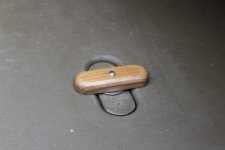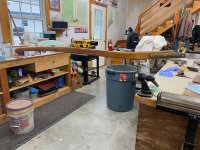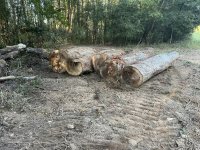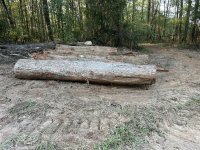Beautiful work. If I may ask, how did you do the tails on the old squaw? They are something...ML/Steve and everyone else great work.
Couple done a lot more to paint
You are using an out of date browser. It may not display this or other websites correctly.
You should upgrade or use an alternative browser.
You should upgrade or use an alternative browser.
October Workbench
- Thread starter MLBob Furia
- Start date
Matt Mahoney
Active member
Don't bury it expecting it to rot! Black locust makes great fenceposts.Thinking I should have thrown this piece of Tupelo in the burn pit before I ever got really far carving it… been about like carving a piece of oak .. makes the knife blade go “tink” when working the back of the neck.
Head alone weighs almost 1/2 lb
View attachment 59495
Matt Mahoney
Active member
Hmmmm, what was I thinking? You said (black) tupelo, not black locust. But black locust does make good fence posts!
The last piece of tupelo I bought a couple of years ago to make some quail out of was as hard as a rock and I'm carving with a Foredom. The basswood I bought at the same time was wonderful. I've had some pretty good tupelo in the past, I was kind of shocked, it wasn't noticeably heavy, but it was like carving walnut or cherry. Don't you wonder if hedge would spark if you carved it in the dark.
Steve Sanford
Well-known member
Matt Mahoney
Active member
Nice Steve. Makes good tillers too.Good morning, Matt~
And Black Locust makes nice turn buttons - to keep floorboards in place....
View attachment 59531
All the best,
SJS
Attachments
I mentioned this in the past but I'll bring it up again. Often when carvers talk about tupelo they mention the wood needs to come from the base of the tree and not the trunk. I'm suspect this is myth. Has anyone who makes that claim ever compared carving wood from the base and further up the tree? I doubt it. Most folks buy whatever chunk their supplier has on hand. Many of those suppliers get those chucks from the mill who got it from the timber company. Did anyone make certain the bases were kept separate from the trunks? I doubt it. Have you ever tried milling the bell shape versus the trunk? The bell shape is a heck of a lot harder to saw than the trunk. Meaning mills won't want to fool with them and they would require custom sawing, if at all. I suspect mills don't separate the bell shape base, instead they remove the taper and saw the entire log where it goes to the middleman who sells it to carvers who have no way of knowing. I talked to a forester friend (AU grad) whose family has been in the sawmill business for decades. He said in all his experiences trees that come from swampy areas with bigger bases, like ash and oak, the bases are harder, not softer than the rest of the tree. He could think of no reason why tupelo would be any different.
This base business is just something that smacks me of internet myth. I don't think people who say it like it is gospel have any evidence. So maybe you got a chunk of tupelo that did happen to be from the base and that is why is is too hard to carve. Who knows?
This base business is just something that smacks me of internet myth. I don't think people who say it like it is gospel have any evidence. So maybe you got a chunk of tupelo that did happen to be from the base and that is why is is too hard to carve. Who knows?
Last edited:
jode hillman
Well-known member
Eric, most of the Tupelo that I've used, be it very little, seem to be cut by a chainsaw. It's never perfectly square and often still has a saw marks in it.I mentioned this in the past but I'll bring it up again. Often when carvers talk about tupelo they mention the wood needs to come from the base of the tree and not the trunk. I'm suspect this is myth. Has anyone who makes that claim ever compared carving wood from the base and further up the tree? I doubt it. Most folks buy whatever chunk their supplier has on hand. Many of those suppliers get those chucks from the mill who got it from the timber company. Did anyone make certain the bases were kept separate from the trunks? I doubt it. Have you ever tried milling the bell shape versus the trunk? The bell shape is a heck of a lot harder to saw than the trunk. Meaning mills won't want to fool with them and they would require custom sawing, if at all. I suspect mills don't separate the bell shape base, instead they remove the taper and saw the entire log where it goes to the middleman who sells it to carvers who have no way of knowing. I talked to a forester friend (AU grad) whose family has been in the sawmill business for decades. He said in all his experiences trees that come from swampy areas with bigger bases, like ash and oak, the bases are harder, not softer than the rest of the tree. He could think of no reason why tupelo would be any different.
This base business is just something that smacks me of internet myth. I don't think people who say it like it is gospel have any evidence. So maybe you got a chunk of tupelo that did happen to be from the base and that is why is is too hard to carve. Who knows?
It's always led me to believe that people were cutting off the flare of the butts and then selling that for carving.
jode hillman
Well-known member
Woodcock, carved painting and done.I mentioned this in the past but I'll bring it up again. Often when carvers talk about tupelo they mention the wood needs to come from the base of the tree and not the trunk. I'm suspect this is myth. Has anyone who makes that claim ever compared carving wood from the base and further up the tree? I doubt it. Most folks buy whatever chunk their supplier has on hand. Many of those suppliers get those chucks from the mill who got it from the timber company. Did anyone make certain the bases were kept separate from the trunks? I doubt it. Have you ever tried milling the bell shape versus the trunk? The bell shape is a heck of a lot harder to saw than the trunk. Meaning mills won't want to fool with them and they would require custom sawing, if at all. I suspect mills don't separate the bell shape base, instead they remove the taper and saw the entire log where it goes to the middleman who sells it to carvers who have no way of knowing. I talked to a forester friend (AU grad) whose family has been in the sawmill business for decades. He said in all his experiences trees that come from swampy areas with bigger bases, like ash and oak, the bases are harder, not softer than the rest of the tree. He could think of no reason why tupelo would be any different.
This base business is just something that smacks me of internet myth. I don't think people who say it like it is gospel have any evidence. So maybe you got a chunk of tupelo that did happen to be from the base and that is why is is too hard to carve. Who knows?
Attachments
MLBob Furia
Well-known member
My only experiences with tupelo lead me to believe that Jode's observation is a valid one.Eric, most of the Tupelo that I've used, be it very little, seem to be cut by a chainsaw. It's never perfectly square and often still has a saw marks in it.
It's always led me to believe that people were cutting off the flare of the butts and then selling that for carving.
Years ago, one of my sources for basswood timbers was a local supplier & milling operation called Paxton Beautiful Woods. They are still in business, but have closed down the fine woodworkers shop that used to be the walk-in part of the operation. Now they deal in bulk orders with contractors and supply all sorts of intricate moldings, etc. Years back ( mid '80's ?) I was in Paxton's selecting some basswood and asked if they ever dealt with Tupelo. The owner took me into a room where the did a lot of re-sawing and showed me a HUGE tupelo flitch standing in a corner. Obviously cut from the bowl end and had been re-sawn flat on the side that had faced out. Had to be over 6' tall and tapered from 4.5' wide at the base to 2.75' up top. Was a fairly uniform 5+" thick. There were spots in it that were kind of "punky", but overall it looked in decent shape.
I asked what they wanted for it, expecting to be given a ridiculous price, but the owner said: "If you'll take the whole damn thing out of here, you can have it for 10 bucks."
Loaded it up, took it home and studied it for a week. I drew on it with chalk to determine where I could get the most useable carving blocks out of it. Well, I carved on that flitch for a few years! Probably ended up with enough prime blocks to do about 15 full-size birds and a whole bunch of miniatures. Was very smooth to carve and took detail well. This was about the time I stopped doing decoratives for contests and switched over to doing all gunning birds. In fact, I think the decorative mallard with the carved & painted acorn in its bill was the final decorative I did back then.
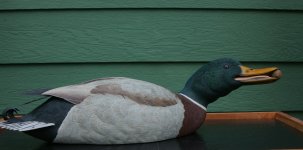


A pair of spatter painted gunning Wigeon from that tupelo:

A pintail "smoothie" done for my wife; also spatter painted:

Last edited:
patrick mccarthy
Well-known member
ThanksBeautiful work. If I may ask, how did you do the tails on the old squaw? They are something...
Its white oak bent to keep the grain structure. They bend without breaking
patrick mccarthy
Well-known member
ThanksPatrick, Patrick, Patrick. Your decoys make me smile. Such imagination and artistry. The Longtail drake on the Mighty Niagara with a tail wind...
The migration is On. Enjoy.
Best regards
Vince
patrick mccarthy
Well-known member
ThanksHoly smokes, these are super fine works of art. They just come to life the way they've been done.
patrick mccarthy
Well-known member
ThanksPatrick~
Exquisite as ever! I'm thinking that Oldsquaw tail was "stolen" from a Dr. Seuss book - no?
All the best,
SJS
Jode and Bob
I have no doubts some suppliers in fact sell wood from the bell and you've found that wood good to work with. What I'm saying is I've not heard anyone definitively state their observations after having carved wood from the bell versus the rest of the tree and I have some doubt that the wood is GREAT from the bell and SUCKS from the trunk which I've seen suggested many times over the years from people with no comparative experience. Further the tupelo I see online appears to be cut from 6x6 or similar beams and as both of you described that's not how wood from the bell looks. My hunch is a lot of folks are carving wood that isn't from the bell and like carving that wood because it too has good carving properties. That's my hunch and when someone steps forward that says "I've carved plenty from both ends of the tree and...." I'll definitely be listening to their experience.
Thanks to both of you for contributing your experiences, and Bob, wow, that mallard is spectacular.
I have no doubts some suppliers in fact sell wood from the bell and you've found that wood good to work with. What I'm saying is I've not heard anyone definitively state their observations after having carved wood from the bell versus the rest of the tree and I have some doubt that the wood is GREAT from the bell and SUCKS from the trunk which I've seen suggested many times over the years from people with no comparative experience. Further the tupelo I see online appears to be cut from 6x6 or similar beams and as both of you described that's not how wood from the bell looks. My hunch is a lot of folks are carving wood that isn't from the bell and like carving that wood because it too has good carving properties. That's my hunch and when someone steps forward that says "I've carved plenty from both ends of the tree and...." I'll definitely be listening to their experience.
Thanks to both of you for contributing your experiences, and Bob, wow, that mallard is spectacular.
Last edited:
Fun project at the shop today. We made 40 hooks in right at 2 hours. Once you set up for the first one it's rinse and repeat. Last season we didn't have a good solution for hanging bags during the hunt and decoys between hunts. We solved that. BTW, I made the bender in the video several years ago and dadgum it comes in handy.
MLBob Furia
Well-known member
True that I can't speak to working with wood up the trunk. In talking with the older guys who loved working in Tupelo, I always thought they considered wood harvested from the bell end was the standard, and that they were very particular about dealing only with suppliers who could provide it. Some of them cut their own, and would search out stumps where the top ends had been cut & hauled away. I also recall hearing from the Cajun carvers that wood up to 4' from the water line was the best.Jode and Bob
I have no doubts some suppliers in fact sell wood from the bell and you've found that wood good to work with. What I'm saying is I've not heard anyone definitively state their observations after having carved wood from the bell versus the rest of the tree and I have some doubt that the wood is GREAT from the bell and SUCKS from the trunk which I've seen suggested many times over the years from people with no comparative experience. Further the tupelo I see online appears to be cut from 6x6 or similar beams and as both of you described that's not how wood from the bell looks. My hunch is a lot of folks are carving wood that isn't from the bell and like carving that wood because it too has good carving properties. That's my hunch and when someone steps forward that says "I've carved plenty from both ends of the tree and...." I'll definitely be listening to their experience.
Thanks to both of you for contributing your experiences, and Bob, wow, that mallard is spectacular.
Rick Pierce
Well-known member
Eric,True that I can't speak to working with wood up the trunk. In talking with the older guys who loved working in Tupelo, I always thought they considered wood harvested from the bell end was the standard, and that they were very particular about dealing only with suppliers who could provide it. Some of them cut their own, and would search out stumps where the top ends had been cut & hauled away. I also recall hearing from the Cajun carvers that wood up to 4' from the water line was the best.
I will second what Bob said. My understanding is that many of the Louisiana carvers went into the swamps with chainsaws and cut the blocks as they stood. What I have heard but have not verified is that they could cut the blocks to decoy size, green, without worrying about checking.
I also know that there was a company in Heber Springs that used tupelo to turn objects (usually fruit like apples, etc.) that were scented as house decorations. They used the logs, as they were harder and were better for lathe turning - the butts or lower ends of the "first" logs on the boles were regarded as too soft and would tear out.
As a forestry student it makes no sense that the bell would be softer, due to the stress, but...that "flare" is a lot of volume. I don't know if it counters the flooded, soft soil by flexing rather than being too stiff and being windthrown, or???
I think tupelo also has more of a "woven" or lattice style fiber than straight...I think some of the Populus spp and maybe even willow have the same thing.
I have carved tupelo that was taken very obviously from the bell, and it was good and soft, but every now and again the grain would get really weird (assume the curve of the bell does things similar to burls, etc.), and/or I would hit hard "rays" similar to oak, and the bird would ripple as sanding uneven hardnesses caused waves. Most of it was really nice, some was a royal pain.
I do know that at some point, the softer wood does transition to very hard. My father hit that on a wood duck - within the length of the body, it went from good carving to more like oak or elm. I know because his knife slipped and he put the blade into his leg (an Xacto knife, so not deep, just bloody).
I have tried unsuccessfully to get permission to cut a few here in Arkansas; I keep trying and will let you know if you want to do some actual testing.
@jode hillman, @MLBob Furia, & @Rick Pierce
I appreciate what you guys are saying and the anecdotes from older hunters you've run across certainly jives with things I've heard said over the years. I have zero doubt that some carvers harvested their own and they specifically went for the bell bottom, positively. But I sure would like to see some comparisons between wood from different parts of the tree to better understand any differences and their magnitude. In my shop right now I have a big hunk of tupelo that we cut four or five years ago from a stand on the property I have permission to hunt. It was taken above the bell. It's about 30" long or so and was approx. 18" before I quartered it on my 36" bandsaw. It feels VERY SOFT to me. In fact, the pith is probably too soft (not rot) to do anything with. I need to take a knife to it just to get a better feel but kind of doubt you'd consider it hard. Taking into consideration Rick's dad's wood duck experience and you all's comments maybe there is a lot of hardness variation within a tupelo, or between tupelos, and the base is the only consistent place to carve from. But for the carver buying bell wood, I would be very leery that what I was getting was from the bell. My hunch is the likelihood I'm getting wood somewhere up the trunk is high, unless the vendor is upfront, honest, and in control of the sawing.
Speaking of wood from the hunting property. Last fall we cleared a swampy area when it got really dry and cut five large white oaks (26" - 38" diameters) and drug them out of the swamp with a D3 bulldozer and bucked them (see below pictures). Just last night these logs were pulled from the bottoms and hauled to a gravel lot near the lodge. I have a portable sawmill coming this weekend to saw them. I'm afraid I may have bitten off more than I can chew! If the sawyer can cut them I have A LOT of hauling and stacking to do, to the tune of 3500 board feet. I am going for quarter sawn. Hopefully the mill can handle the logs, and we can flip them for quarter sawing. Getting these logs sawn, moved to my shop, and stacked is going to be a challenging task to say the least.
I appreciate what you guys are saying and the anecdotes from older hunters you've run across certainly jives with things I've heard said over the years. I have zero doubt that some carvers harvested their own and they specifically went for the bell bottom, positively. But I sure would like to see some comparisons between wood from different parts of the tree to better understand any differences and their magnitude. In my shop right now I have a big hunk of tupelo that we cut four or five years ago from a stand on the property I have permission to hunt. It was taken above the bell. It's about 30" long or so and was approx. 18" before I quartered it on my 36" bandsaw. It feels VERY SOFT to me. In fact, the pith is probably too soft (not rot) to do anything with. I need to take a knife to it just to get a better feel but kind of doubt you'd consider it hard. Taking into consideration Rick's dad's wood duck experience and you all's comments maybe there is a lot of hardness variation within a tupelo, or between tupelos, and the base is the only consistent place to carve from. But for the carver buying bell wood, I would be very leery that what I was getting was from the bell. My hunch is the likelihood I'm getting wood somewhere up the trunk is high, unless the vendor is upfront, honest, and in control of the sawing.
Speaking of wood from the hunting property. Last fall we cleared a swampy area when it got really dry and cut five large white oaks (26" - 38" diameters) and drug them out of the swamp with a D3 bulldozer and bucked them (see below pictures). Just last night these logs were pulled from the bottoms and hauled to a gravel lot near the lodge. I have a portable sawmill coming this weekend to saw them. I'm afraid I may have bitten off more than I can chew! If the sawyer can cut them I have A LOT of hauling and stacking to do, to the tune of 3500 board feet. I am going for quarter sawn. Hopefully the mill can handle the logs, and we can flip them for quarter sawing. Getting these logs sawn, moved to my shop, and stacked is going to be a challenging task to say the least.



